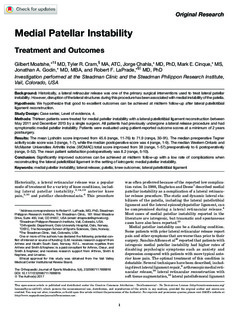| dc.contributor.author | Moatshe, Gilbert | |
| dc.contributor.author | Cram, Tyler R. | |
| dc.contributor.author | Chahla, Jorge | |
| dc.contributor.author | Cinque, Mark E. | |
| dc.contributor.author | Godin, Jonathan A. | |
| dc.contributor.author | LaPrade, Robert F. | |
| dc.date.accessioned | 2018-05-18T12:21:51Z | |
| dc.date.available | 2018-05-18T12:21:51Z | |
| dc.date.created | 2017-10-12T18:12:56Z | |
| dc.date.issued | 2017 | |
| dc.identifier.citation | The Orthopaedic Journal of Sports Medicine. 2017, 5, 2325967117699816. | nb_NO |
| dc.identifier.issn | 2325-9671 | |
| dc.identifier.uri | http://hdl.handle.net/11250/2498582 | |
| dc.description | This open-access article is published and distributed under the Creative Commons Attribution - NonCommercial - No Derivatives License (http://creativecommons.org/licenses/by-nc-nd/3.0/), which permits the noncommercial use, distribution, and reproduction of the article in any medium, provided the original author and source are credited. You may not alter, transform, or build upon this article without the permission of the Author(s). For reprints and permission queries, please visit SAGE’s website at http://www.sagepub.com/journalsPermissions.nav. | nb_NO |
| dc.description.abstract | Background: Historically, a lateral retinacular release was one of the primary surgical interventions used to treat lateral patellar instability. However, disruption of the lateral structures during this procedure has been associated with medial instability of the patella. Hypothesis: We hypothesize that good to excellent outcomes can be achieved at midterm follow-up after lateral patellotibial ligament reconstruction. Study Design: Case series; Level of evidence, 4. Methods: Thirteen patients were treated for medial patellar instability with a lateral patellotibial ligament reconstruction between May 2011 and December 2013 by a single surgeon. All patients had previously undergone a lateral release procedure and had symptomatic medial patellar instability. Patients were evaluated using patient-reported outcome scores at a minimum of 2 years postsurgery. Results: The mean Lysholm score improved from 45.6 (range, 11-76) to 71.9 (range, 30-91). The median preoperative Tegner activity scale score was 3 (range, 1-7), while the median postoperative score was 4 (range, 1-9). The median Western Ontario and McMaster Universities Arthritis Index (WOMAC) total score improved from 38 (range, 1-57) preoperatively to 6 postoperatively (range, 0-52). The mean patient satisfaction postoperatively was 8.2 (range, 5-10). Conclusion: Significantly improved outcomes can be achieved at midterm follow-up with a low rate of complications when reconstructing the lateral patellotibial ligament in the setting of iatrogenic medial patellar instability. | nb_NO |
| dc.language.iso | eng | nb_NO |
| dc.subject | medial patellar instability | nb_NO |
| dc.subject | lateral release, patella | nb_NO |
| dc.subject | knee outcomes | nb_NO |
| dc.subject | lateral patellotibial ligament | nb_NO |
| dc.title | Medial patellar instability: Treatment and outcomes | nb_NO |
| dc.type | Journal article | nb_NO |
| dc.type | Peer reviewed | nb_NO |
| dc.description.version | publishedVersion | nb_NO |
| dc.rights.holder | © The Author(s) 2017 | nb_NO |
| dc.source.journal | The Orthopaedic Journal of Sports Medicine | nb_NO |
| dc.identifier.doi | 10.1177/2325967117699816 | |
| dc.identifier.cristin | 1504304 | |
| dc.description.localcode | Seksjon for idrettsmedisinske fag / Department of Sport Medicine | nb_NO |
| cristin.unitcode | 150,34,0,0 | |
| cristin.unitname | Seksjon for idrettsmedisinske fag | |
| cristin.ispublished | true | |
| cristin.fulltext | original | |
| cristin.qualitycode | 1 | |
